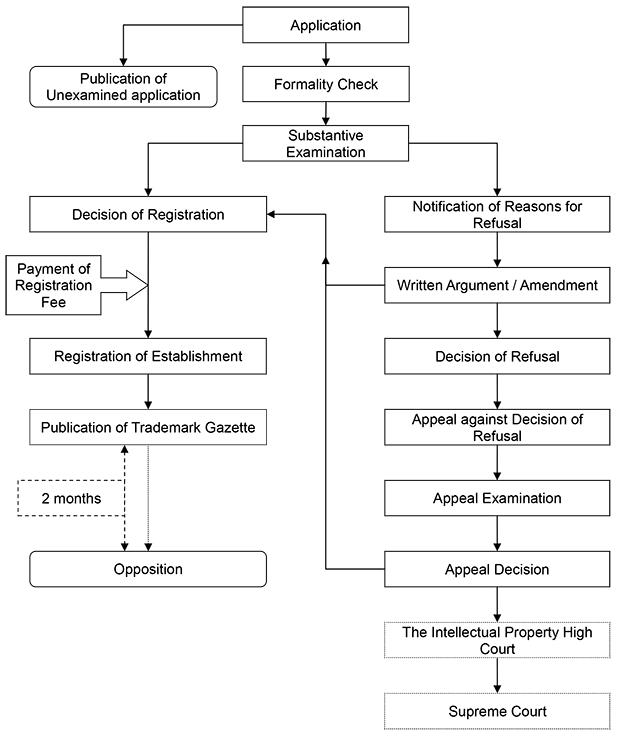

Intellectual Property News in Japan
1) Trademark Search
All trademark applications undergo an official database search for prior marks, but it takes several months for this process to be completed. Accordingly, it is always advisable to conduct a trademark search before filing an application in order to avoid unnecessary costs caused by adopting marks which conflict with someone’s prior right.
The Japanese Patent Office (JPO) provides a trademark database available on the internet for free which is called as “Japan Platform for Patent Information (J-PlatPat).” On this database you can search trademark applications and registrations, well-known Japanese marks as well as acceptable identifications of goods or services, etc., at the following link:
https://www.j-platpat.inpit.go.jp/web/all/top/BTmTopEnglishPage
2) The registration process
2-1 The information necessary for filing a trademark application
We need the following information and documents for filing a trademark application in Japan.
– A specimen or depiction of the trademark
– A list of goods/services to be covered by the application
– The applicant’s formal name, address and nationality
> Priority Claim
It is possible to claim a priority right under the Paris Convention. If you wish to claim the priority right, please inform us of the filing date and the country name of the first application. A certified copy of the first application as filed has to be submitted within 3 months from the filing date of the Japanese application.
> Power of Attorney
Please be advised that, when filing a trademark application, no Power of Attorney is required.
2-2 Registrable marks
The following signs that are capable of distinguishing the goods or services of one entity from another are registrable as a trademark:
– Words, devices, three-dimensional shapes or any combination thereof, or any combination thereof and colors
In addition to regular trademark registrations, collective marks, regional collective marks, defensive marks*, and service marks may also be registered.
* A defensive mark is a trademark applied for by a trademark owner of a famous mark for goods and or services other than the goods/services designated in the original trademark registration. The registration of a defensive mark can prevent a third party from registering and using a mark which is identical to the defensive mark on the goods/services designated in the defensive mark registration. A defensive mark registration is immune to cancellation action based on non-use of the mark.
> Non – Traditional Trademarks
As from April 1, 2015, non-traditional trademarks, such as Motion Marks, Hologram Marks, Color per se marks, Position Marks and Sound Marks, are registrable in Japan.
2-3 Classification
Japan has adopted the 11th edition of the International Classification as of January 1, 2017.
> Class Headings:
The class headings of the Nice Classification are not accepted because they are considered to be too broad.
> Multi Class application:
Multi-class applications are available in Japan.
> Retail Services:
The JPO has been accepting the registration of retail and wholesale services since April 1, 2007.
2-4 Filing Fee (Application Fees)
- a) One trademark in one class: 12,000 yen.
b) One trademark in multiple classes: 12,000 yen for the first class, and an additional 8,600 yen for each additional class.Note that the above amounts are official fees only and do not include our service fees.
3) Examination
The JPO examines whether an application fulfills the substantive requirements such as distinctiveness, the existence of prior applications/registrations etc., as well as the formal requirements. It will generally take 4 months to 7 months until a first official action (decision of registration or notice of refusal) is issued.
> Accelerated Examination
In the case of an emergency, the examination can be accelerated upon request. The acceleration of trademark examination is accepted if the trademark application only designates the goods/services to which the applied mark has actually used, or it is an emergency case (the applied mark is being used by an unauthorized party, etc.)
> Office Action
When the JPO examiner finds any reason for refusal of registration, the examiner issues a preliminary notice of refusal. The initial term for responding to the Office Action is 3 months from the date of the issuance of the notification. Under the current practice, a 1 month extension of this deadline and a subsequent 2 month extension are available.
> Amendment of Goods/Services
An applicant can amend identifications of goods and services designated in a trademark application after filing at any time during the examination, in order to limit or clarify the original goods and services. However, the amendment of goods/services cannot be made beyond the scope of the original goods and services at the time of filing.
Please note that, as for Madrid Protocol applications, an amendment is allowed before the JPO only within the fixed term in which a response to the provisional refusal can be filed.
> Amendment of Trademarks
Only very minor amendments are allowed to the trademark itself.
Please note that with respect to Madrid Protocol applications, the amendment of trademark is not allowed.
> Letter of Consent/Co-existence Agreement
The JPO does not accept the submission of a letter of consent or the like to overcome the conflicting prior mark in Japan.
4) Registration
If the JPO examiner finds no reason for refusal of registration, the examiner issues a decision of grant of the trademark. The applicant must pay the registration fee within 30 days from the issuance of the grant decision. Otherwise, the application will be dismissed. The registration fee is 28,200 yen per class which covers only the official fees.
The duration of a trademark registration is 10 years from the registration date.
5) Appeal
If the trademark application is eventually refused by the examiner, regardless of submitted arguments, the applicant can file an appeal before the Trial and Appeal Board of the JPO within 3 months from the issuance of the final refusal decision. The appeal deadline is NOT extendable.
6) Opposition
After registration, the trademark is published in the Trademark Gazette for opposition purposes. Anyone may file an opposition within 2 months from the date of publication. The deadline for filing the opposition is NOT extendable.
7) Invalidation trial
An invalidation trial is available to attempt to have a trademark registration cancelled. Any person who has a legal interest can file an invalidation trial against the trademark registration based on a prior registration, the lack of distinctiveness, or unregistered famous mark, etc. An invalidation trial can be filed at any time after registration, but certain reasons for an invalidation of registration, such as the lack of distinctiveness and/or a prior registration, etc. cannot be claimed as grounds for an invalidation trial after 5 years from the registration date.
8) Non-use Cancellation
If the registered trademark has not been used over the past three years, anyone can request a cancellation trail against the registration based on non-use.
An owner of a trademark registration has the burden of proof to prove that the mark has been used over the past three years by the owner or a licensee, or that there is a justifiable reason which excuses non-use. It is not necessary for the plaintiff to submit any evidence proving the non-use of the trademark at the time of filing the non-use cancellation trial. If the owner does not submit any evidence showing the use of the mark with respect to any of the goods/services which are sought to be cancelled, the JPO will issue a trial decision to order that the registration be cancelled.
9) Renewal
A request for renewal must be submitted within 6 months before the expiry date. If no request has been filed in time, late renewal is still possible within a grace period of 6 months by paying a surcharge of double the amount of the usual renewal fee.
Neither proof of use nor a signed Power of Attorney is required to renew the registration.
The renewal fee is 38,800 yen per class which covers only the official fee.
10) Registered Trademark Notice
It is not compulsory to put a registered trademark symbol after the registered trademark. The use of registration trademark symbol will not give you any additional legal protection. Under the Japanese trademark Law, a notice of trademark registration is done by displaying the phrase “Registered Trademark” and its registration number.
The circled capital letter “R” is not an official trademark registration notice in Japan, but it is commonly used in the marketplace.
11) Madrid Protocol
Japan joined the Madrid Protocol in 2000. Accordingly, you can file an international application designating Japan to register a mark.
